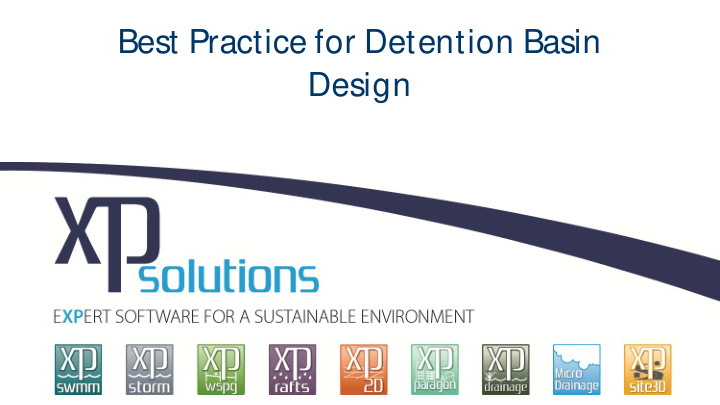



Best Practice for Detention Basin Design
Gavin Fields Senior Water Resources Engineer XP Solutions
XPSolutions � Software for modeling wastewater, stormwater, and floods � Graphical User Interface (GUI) and analytical engines � CAD/GIS type interface and data management tools � Graphical reports, maps, animations � 1D analytical engine solves the complete St. Venant (Dynamic Flow) equations for gradually varied, one dimensional, unsteady flow � 2D analytical engine embedded as xp2D
XP-LIVE Webinars � This is part of our XP-LIVE educational program � Webinars have been recorded and are available at http://www.xpsolutions.com/ � Question/Answer
Best Practice for Detention Basin Design � Introduction � Theory � Application � Demonstration � Q&A
Introduction Why do we need / design detention devices? Developed Pre-developed
The good
The bad
The ugly
History � The impact of development has been directly observed throughout history � Engineers and scientists challenged themselves to understand stormwater systems to protect our populations, buildings and infrastructure � Thus the field of hydrology evolved… and at times detention basins are seen to be the ‘ cure’
Theory � Detention relies on the principle that flows can be delayed by the addition of storage or a new loss to the system � Calculations must conserve mass and energy � For orifice controls a key equation is: �� � � � ( � ) � � � ( � ) = 1 � � ( � ) � ��
Theory � Open detention basins that are subject to infiltration calculations are driven by depth, generally based on Darcy’s Law, Horton or Green-Ampt Equations
Application � Industrial Site – 2.83ha – 80% Impervious
Application Indu ndustr strial ial Si Site: 1 te: 100 00 Year ear 90 90 Mi Minute nute Di Discharges scharges 0.6 0.5 0.4 Discharge (m 3 / s) 0.3 Existing 0.2 0.1 0 0:00 0:14 0:28 0:43 0:57 1:12 1:26 1:40 Tim e Tim e
Application Indu ndustr strial ial Si Site: 1 te: 100 00 Year ear 90 90 Mi Minute nute Di Discharges scharges 0.6 0.5 0.4 Discharge (m 3 / s) 0.3 Existing Developed 0.2 0.1 0 0:00 0:14 0:28 0:43 0:57 1:12 1:26 1:40 Tim e Tim e
Application Indu ndustr strial ial Si Site: 1 te: 100 00 Year ear 90 90 Mi Minute nute Di Discharges scharges 0.6 0.5 0.4 Discharge (m 3 / s) Existing 0.3 Developed Orifice 0.2 0.1 0 0:00 0:14 0:28 0:43 0:57 1:12 1:26 1:40 Tim e Tim e
Types � Types � Open solutions (parks, ponds, lakes, etc.) � Cost effective to build, but land consumptive � Closed solutions (rainwater tanks, underground storage) � Expensive to build, but increase yield
Example Closed Solutions SPEL StormChamber
Example Closed Solutions SPEL Aquaflo
Controls � Structural controls include: � Orifices; and � Pipes; � Valves. � Weirs;
Controls
What makes a good detention basin?
Low Head
Clever Control Example � Hydraulic Brakes
Optimised for Depth/Area/Discharge
Modelling Detention Basins � 1D data requirements � Node Data � Link Data � Storage � Geometry � Geometry � Flow � Inflow � Losses, e.g. roughness and structure impacts
Tailwater Effects
Software Demonstration
Questions? Comments? Thank you for joining this presentation, Best Practice for Detention Basin Design By Gavin Fields gavin.fields@ xpsolutions.com Contact XP Solutions Americas: +1 888 554 5022 amsales@ xpsolutions.com Asia Pacific: +61 7 3310 2302 ausales@ xpsolutions.com EMEA: +44 0 1635 582555 uksales@ xpsolutions.com www.xpsolutions.com
Recommend
More recommend